Dove manca la natura bisogna l’arte sia maestra
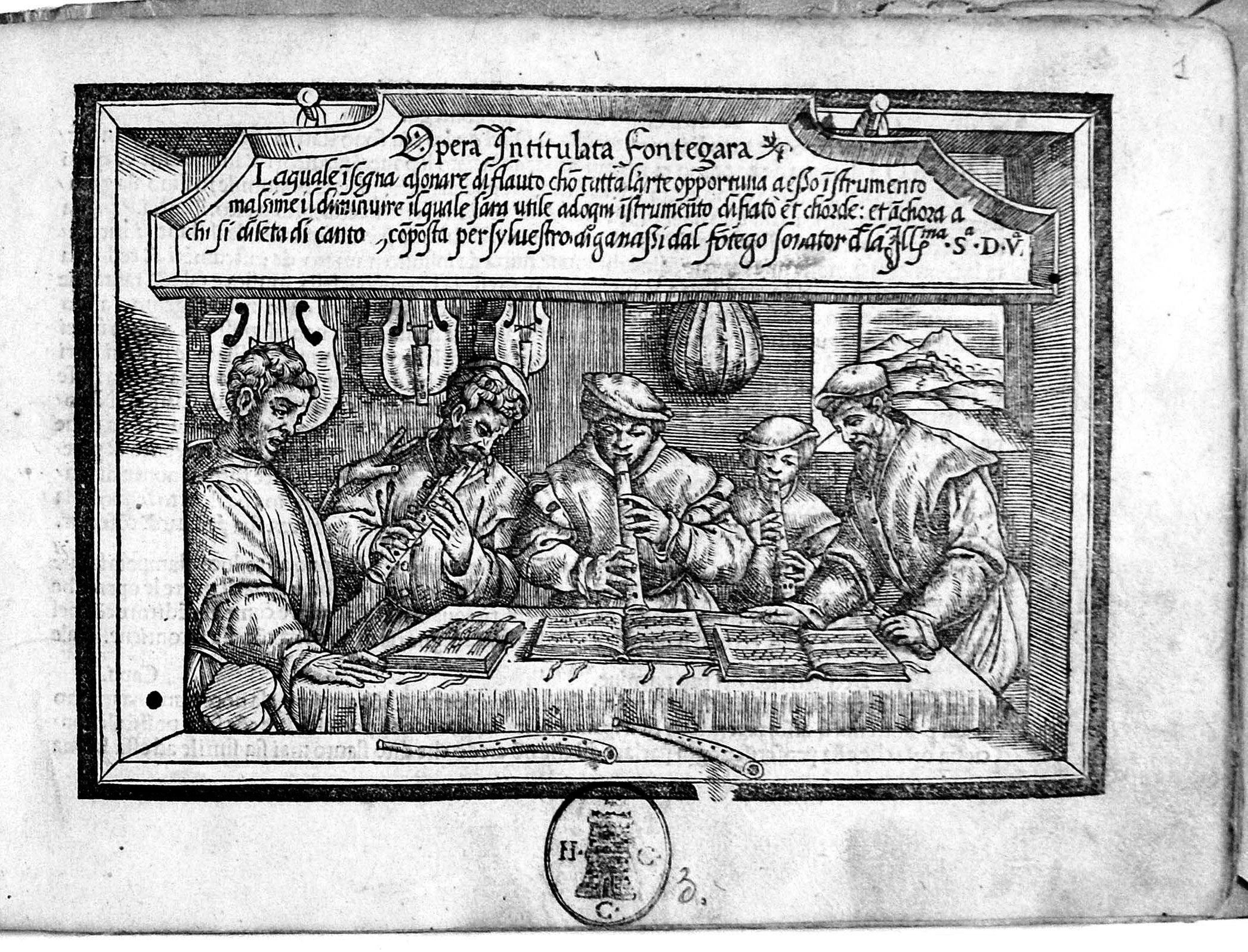
New research developments on Silvestro Ganassi’s Opera Intitulata Fontegara
Dina Titan
The frontispiece of Silvestro Ganassi’s Fontegara (Venice 1535) inspires modern musicians and scholars to imagine the richness of the instrumental performance practice described in the treatise. Through a window frame, the viewer is invited to admire how five musicians, united around a table, engage in performance. Apart from the recorders the musicians hold in their hands, most likely the members of the Ganassi dal Fontego family, the image insinuates that they were equally proficient in other instruments, as the image includes three violas da gamba, two cornetti and a lute. The choice of instrumentation seen in this famous title-page is simply one of the many acceptable variants for a sixteenth-century ensemble, hinting that other combinations were also suitable as confirmed by the full title of the treatise.
The treatise is the first sixteenth-century tutor which, besides a thorough discussion on recorder technique, offers an immense quantity of examples teaching how to embellish a given interval with faster moving notes, i.e. the art of diminutions.
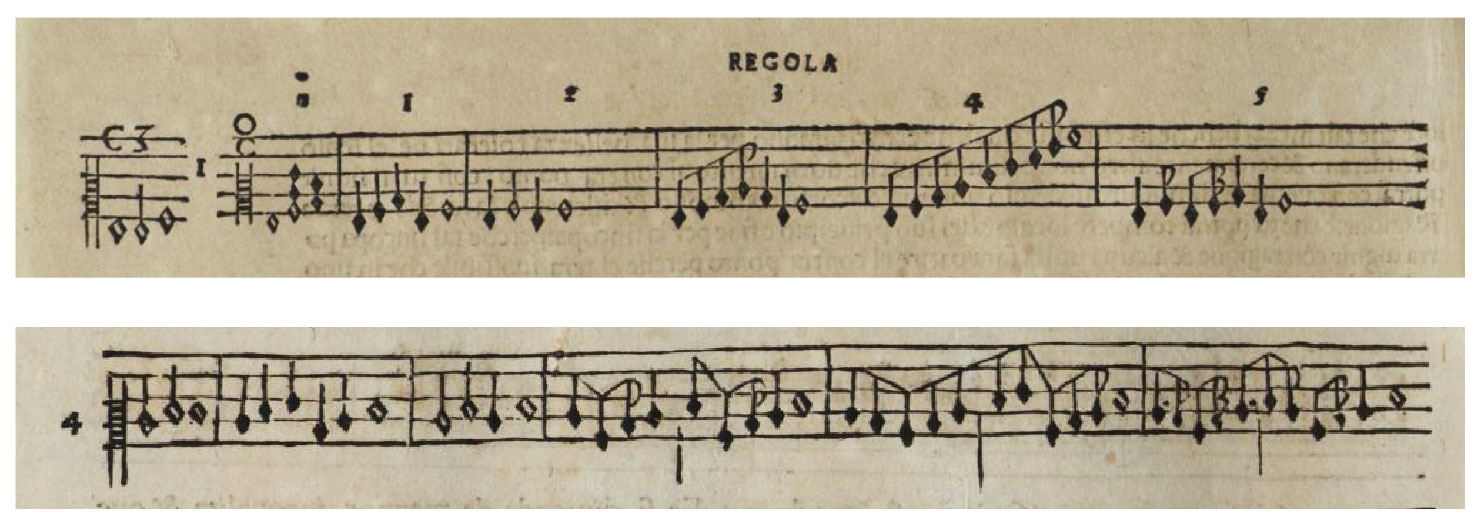
Diminutions of an ascending second according to the proportions of Regola Prima and Regola Seconda
Whereas the frontispiece seems to offer an entrance point for our modern understanding of sixteenth-century instrumental practices, Ganassi’s Fontegara poses serious questions to our views of the sixteenth-century Venetian diminution tradition. However, a complete academic study of Fontegara was long overdue. Although Ganassi’s treatise stands isolated from similar Venetian diminution treatises for nearly fifty years, it is its content which sets the treatise further apart. Different to the later treatises, Fontegara offers very detailed and categorised instructions on recorder and an extensive quantity of very complex diminution examples.
The recent PhD dissertation “The origins of instrumental diminution in Renaissance Venice: Ganassi’s Fontegara” (Dina Titan, University of Utrecht) reviews the pertinent questions, and offers a new interpretation of the textual and musical content of this astonishing historical source. The PhD research was funded by the NWO (Dutch Organisation for Scientific Research), and it approaches Fontegara from different viewpoints and through several research methodologies.
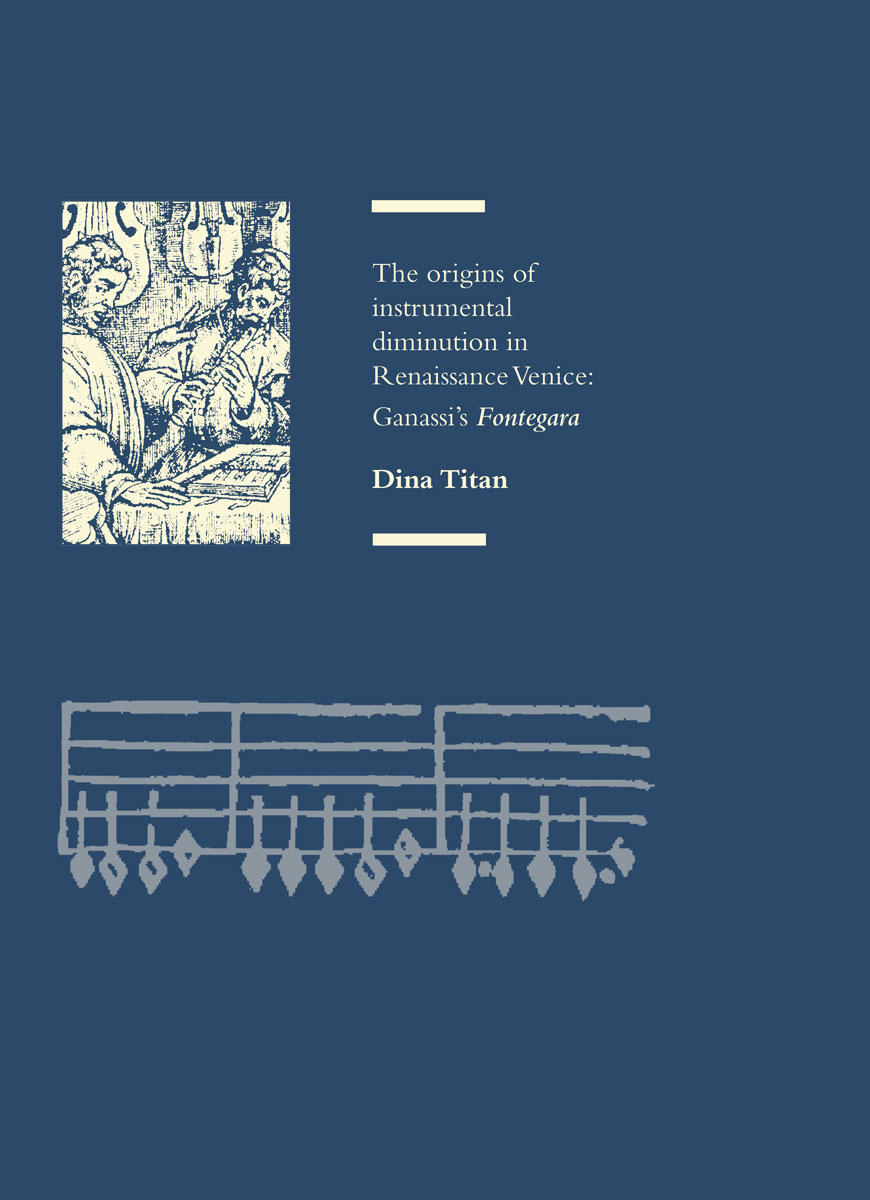
In short, the research focusses on Fontegara as a product of the emergent printing business, offering a study of the print history and a comparison of the eight surviving copies of Fontegara, which to date, were thought to be identical. From a musicological point of view, it also analyses the content of the text (focussing on recurrent artistic terminology) and its numerous diminution examples. The stylistic analysis brings to the fore elements that can be found in all Regole in spite of their different proportions. These recurrent traits are presented in an orderly and categorised manner, defining what is typical of Ganassi’s style. The dissertation also places the treatise and its author within the Venetian cultural and artistic milieu it was conceived. The corpus of interdisciplinary references to other artists and other artistic fields plays a significant role. Additionally, the study of the prose of Ganassi’s three instrumental treatises, including Regola Rubertina and Lettione Seconda (Venice 1542 and 1543) made it possible to pinpoint recurrent topics and terminology that play a central role in Ganassi’s understanding of the arts. Finally, taking into account the results of all methodologies, the dissertation proposes an entirely new interpretation of Fontegara.
It soon became obvious that it would be necessary to produce a new academic translation of Fontegara, as the current English version is, in fact, a translation of Hildemarie Peter’s German translation. Annexe I of the dissertation offers an annotated transcription of the Italian original text and a diplomatic English translation of the treatise in parallel pagination so that the reader can continuously compare the transcription and translation. The transcription remains loyal to the original text, presenting as it stands in most copies, including its numerous inaccuracies. There are a few discrepancies between the extant copies, so it is clear that book was subjected to some level of proof-reading and editing, as discussed in the dissertation. A significant number of imperfections was left behind both in the text and many diminutions also contain rhythmical inaccuracies (listed in Annexe II), which could be a result of the complexity of its style. The dissertation discusses the differences between the eight copies, offering an insight in the printing process. The translation aims to be a practical tool for further study and to grant transparent access to the text. For that reason, it remains extremely close to the original Italian, and any necessary additions and explanations are made visible to the reader by use of brackets and footnotes.
Central to the dissertation is the decision to use the different methodologies to place Ganassi within his own cultural and socio-economic milieu avoiding any anachronistic comparison to later diminution treatises. Certainly, a glimpse on the later diminution treatises would be sufficient to observe how distinct Ganassi’s approach is. Fontegara is alone in its use of proportions (including 5/4 and 7/4), complex rhythmic figures with extensive use of dotted rhythms, systematic re-ordering of rhythmic figures, use of rests, the presence of vertical dashes subdividing the diminutions in two halves and the presence of purely rhythmic diminutions (in which the melodic aspect of the ornamentation is reduced to the minimum). To anachronistically compare Fontegara to treatises such as Dalla Casa’s Il vero modo di diminuir or Bassano’s Ricercate, Passaggi et Cadentie (Venice 1584 and 1585, respectively) might serve as a methodology to understand the continuous changes of style throughout the century, but it does not offer any insight on the core principles of Ganassi’s treatise. In fact, Ganassi was no longer alive when these later treatises were published! A better understanding of his oeuvre can only depart from the study of Fontegara as a product of his time, placing the treatise within its own social, artistic and cultural milieu.
Socio-economic condition of Venetian instrumentalists and Ganassi’s self-fashioning
Recent research has recovered new biographical information on Ganassi and serves here as an introduction to the socio-economic condition of instrumentalists in Venice. Silvestro was the son of an immigrant from Bergamo and already in 1517, the young 25-year-old musician was hired as suonatore del Doge. To complement their income, the Ganassi family ensemble (known as the suonatori dal fontego) performed regularly in the Venetian ridotti. Ganassi was also active in the musical gatherings of two Florentine gentlemen, Neri Capponi and Ruberto Strozzi (the dedicatees of Lettione Seconda and Regola Rubertina). The Ganassi family’s sobriquet is a reference to their place of residence: the fontego della farina. The terms fontego and fondaco were used to refer to warehouses, used for storage and trade of cereals, flour and other such-like products. Featuring the image of his own family, the frontispiece possibly served very mundane purpose: as propaganda for the Ganassi ensemble. Moreover, Fontegara’s title is a direct reference to the author’s surname demonstrating his awareness of the importance of the printed book as means to self-promotion.
In his opening statements addressed to Doge A. Gritti, Ganassi states that the book is the result of his laborious and diligent efforts (molte mie fatiche & lucubratione). A newly recovered document (ASVe, Senato Terra, reg. 28, c.215) dating from December 22 1535, states that 135 members of the Venetian Senate agreed with fairly unusual conditions of Ganassi’s request of privilege for Fontegara (curiously, 10 senators abstain from voting and 6 were against it!). Also in this document Ganassi’s treatise is described in strikingly similar terms, i.e. the meritevole fructo delle virtuoso fatiche sue (the “worthy product of his virtuous efforts”). The document confirms Ganassi involvement in the printing process as the Senate agrees to all terms requested by the author. The requested privilege, better understood as the equivalent to a modern patent or copyright protection, exceeds the typical terms: 20 years of protection (the norm was around 15 years), subject to severe penalties to the illegal printing or selling within the territories of the Venetian Republic of any similar works, even if with printed elsewhere without the permission of the author. The high fine defined in Fontegara’s privilege statement (10 ducats per illegally produced book encountered either in the hands of the seller or printer) exceeds the usual amount and it is, therefore, possibly an indicator of the expected musical value of Fontegara. Ganassi was not only protecting his financial investments but also the ‘concept’ of his treatise, as indicated by the prohibition to produce any similar works. So, what precisely in Fontegara was the product of Ganassi’s limitless intellectual efforts and worthy of such extensive legal protection?
Ganassi’s awareness of the commercial value of the printed book should be understood within the parameters of the precarious socio-economic position of the Renaissance instrumentalist who, even in a musically blooming society as Venice, earned less than singers and composers. For example, it was fairly common for musicians (and painters) to have more than one profession: Ganassi’s brother was, like their father, also a barber (and the painter Giorgione also played the lute). It is not really surprising that instrumentalists (and painters) felt the need to engage in the artistic debate on the social valorisation of the arts, distancing themselves from the manual character of their profession presenting the arts as product of their intellectual capacities.
In regard to the financial condition of the Ganassi family, it is also interesting to note that they complemented their income through other means. The tax declaration of Girolamo and Silvestro Ganassi (ASVe, X Savi alle decime, busta 88, n. 769 dating from 1532) shows that the family also engaged in trade of products such as flour, ferment, beans, wine and rental of a section of their property to a certain Menegeto della Villa. These parallel commercial activities and the family’s place of residence (the Fontego della farina) point to a new significance of the family’s sobriquet: Dal Fontego indirectly describes their additional source of income. Most importantly, the somewhat precarious financial situation of the Venetian instrumentalist could well have functioned as a propelling force for the engagement of Silvestro in the printing business as a means of self-promotion and propaganda.

Fonteghetto della Farina, painting by Canaletto circa 1730
The dissertation places Ganassi at the very centre of the Venetian cultural and artistic life through an analysing the corpus of references carefully built into the texts of his three treatises. For example, in Rubertina and Lettione, Ganassi makes sure to associate himself to great musicians such as Gombert and A. Willaert, “dropping names” in a manner far from discrete. The reader cannot help to notice Gombert’s name written in capital letters as Ganassi introduces the maestro di cappella’s intonation systems for ensembles! The praise of Adrian Willaert cannot be taken lightly: Willaert was brought to Venice as a result of Doge Gritti’s extensive programme to invest in the Serenissima’s cultural institutions: the renovatio urbis. Through the reference to these famous m
aestri di cappella, Ganassi claims and projects onto himself the same level of musicianship and authority.
Ganassi continues to make use of this literary strategy, praising the proficiency of many other instrumentalists, such as Francesco da Milano, Rubertino Mantoano and Alfonso da Ferrara. By giving these men a compliment and proceeding to discuss the very same level of instrumental proficiency in his own treatise, Ganassi makes clear to the reader that indirectly, he too must be viewed as one of these virtuoso instrumentalists. Strikingly, Ganassi never mentions any other musician in Fontegara. As said above, the only musicians to be featured in his first treatise, are the ones belonging to his own family, making it explicit, once more, that Fontegara is a product of his own intellect.
The sketch of Ganassi’s cultural milieu needs to include the composers of two madrigals present in Lettione. Giacomo Fogliano’s madrigal Io vorei dio d’amore serves as an example on how to perform a madrigal singing one voice whilst playing the remainder on the viola da gamba (here too, Ganassi uses the “dropping of names” to praise Guliano Tiburtino and L. Lasagnino). Giacomo and his brother Ludovico Fogliano, author of Musica Theorica (Venice 1529), were active in Venice during the first half of the century. Ludovico was fluent in Greek and highly valued for his intellectual abilities by none other than Pietro Aretino (see below for a short discussion on the importance of these men). The other madrigal is used as an example of tablature, and it was only now been identified by this research as Jhan Gero’s Io penso, pensier, pensieri.
From another point of view, Ganassi does not waste any opportunity to praise the instrumental art and required skills of the proficient instrumentalist. The reader is often reminded of the necessity to use the ‘ear’ in matters of intonation, the giudicio della orecchia, moving away from the theoretical approach, i.e. mathematical ratios. Ganassi clearly values the empirical approach explaining that throughout his life, he has diligently experimented and has expanded his skills beyond the normal standards. Fontegara’s fourth chapter is very illustrative containing a boastful announcement of the results:
My most dignified reader, you should know that I have experimented for many years on how to play, and I have enjoyed watching and practising with the foremost performers that have lived in my time. However, I have never encountered a dignified man in this art who had employed [in his performance] other notes besides the ordinary ones. I mean to say, they might have added one or two notes, whereas I have investigated it in such a way that I discovered that, which others did not know [existed], i.e. seven additional notes aside from the ordinary ones. It is not that they were not acquainted with the way to proceed but, due to fatigue, they gave up.
Many other similar quotes demonstrate a new understanding of the instrumentalists’ qualities: the well-trained ears, practice, diligence and experimentation are seen as positive elements that inform performer’s appropriate artistic judgements (bona discretione). However, Ganassi was not alone in proposing the new understanding of the instrumental empirical quality. Among others, the theorist Ludovico Fogliano revisits in his Musica Theorica matters of intonation departing from the same empirical viewpoint, granting the aural discernment or the sense perception a primordial role (including a new understanding of the imperfect consonances). Fogliano’s choices (and by extension Ganassi’s) should also been understood within a much longer theoretical tradition, moving away from the Pythagorean definition of perfect consonances as the expression of certain mathematical ratios. Instead, both authors promote the trust on sense perception as final judge of aural matters as defined by Aristoxenus of Tarentum.
Last but not least, the study of the prose of Ganassi’s texts brought an astonishing observation to the fore. Ganassi re-states one single motto five times in his three treatises. It reads: Dove manca la natura bisogna l’arte sia maestra (“where nature is lacking, art must assume a leading role”), and thus moves away from the understanding that art should imitate nature by giving art a leading role. Although the scope of the present article does not allow for an in-depth discussion of the motto, it is sufficient to state that Ganassi applies it when discussing intonation, therefore, valuing the practical musician as primordial arbiter of musical matters. Interestingly, the motto is also very similar to the one given to Titian’s in B. Pittoni and L. Dolce’s impresa: Natura Potentior Ars. Underneath the motto, the image displays a she bear licking her cub into shape establishing a comparison to the artist’s creative power shaping (or surpassing) nature, and a poem praises the acclaimed member of the Venetian artistic triumvirate and close friend of Aretino. Both Ganassi’s and Titian’s mottos propose a new understanding of the art and artists.
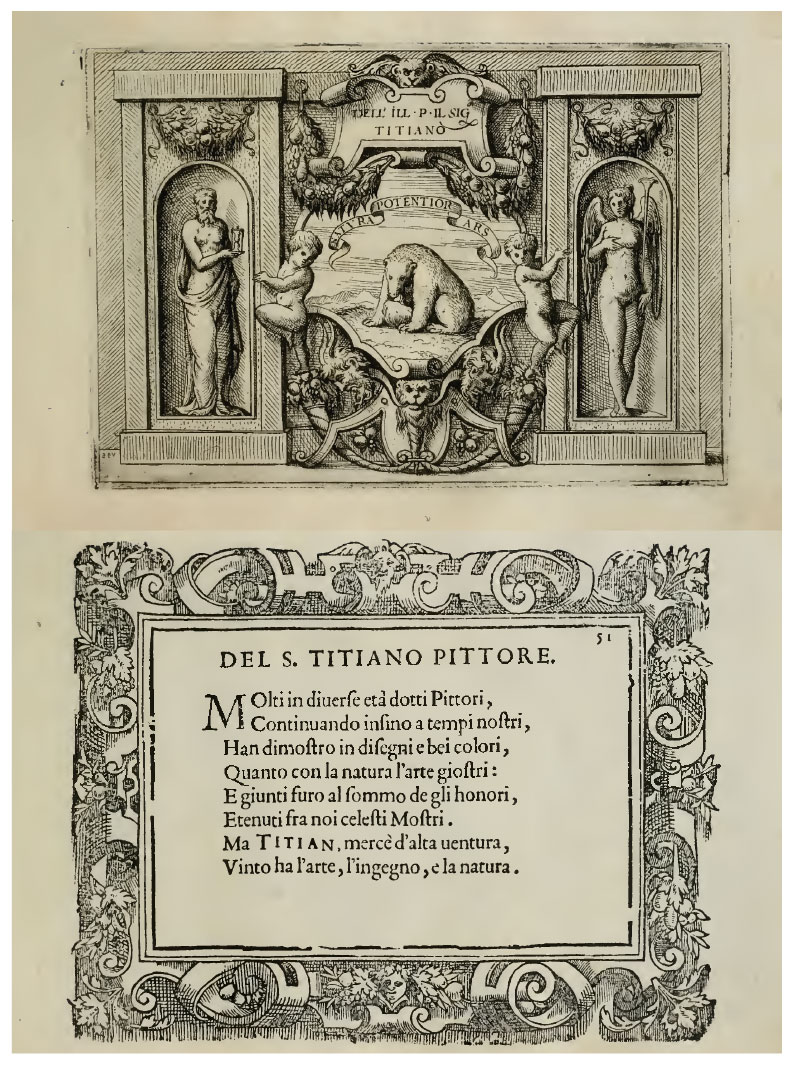
»Natura potentior ars« – Titian’s motto. B. Pittoni (*1520); L. Dolce (1508-1568): »Imprese di diuersi prencipi, duchi, signori, e d’altri personaggi et huomini letterati et illustri: con alcune stanze del Dolce che dichiarano i motti di esse imprese« (Venice 1562).
This far, we have seen how Ganassi consistently proposes a new understanding of instrumental skills and uses the printed book as instrumental to self-promotion. To complete the sketch of his cultural milieu, it is also necessary to include the fact that other writers and artists seemed to value Ganassi to such a degree, that they too were eager to use the same “dropping of names” strategy, but now to associate themselves to Silvestro Ganassi. Ganassi’s instrumental skills are praised by literati such as Oriolo da Bassano and Teofilo Folengo. Girolamo Cardano paraphrases large sections of Fontegara in his De Musica. But perhaps the most interesting and revealing quotes, placing Ganassi at the very centre of Venetian cultural life, are found in two slightly later writings related to the field of visual arts: Paolo Pino Dialogo di Pittura and, Ludovico Dolce’s Dialogo della Pittura L’Aretino (Venice 1548 and 1557 respectively). Both authors praise Ganassi for his intellectual and musical capacities, but are equally at awe of his skills in the field of visual arts, as confirmed by Ganassi’s claim to be desideroso della pittura (“keen to master painting”) on the title-page of Lettione Seconda. Last but not least, Ganassi is praised in many of the reprints of Francesco Sansovino’s guide to Venice. The son of the great architect responsible for so many of the structural projects of Andrea Gritti’s renovatio urbis, deems it important to mention our instrumentalist in many of the reprints of Delle cose notabili.
Ganassi most likely knew these men, but most importantly, the sketch of Ganassi’s social circle starts to define new grounds for our understanding of his artistic views, placing him as an engaged member of a much broader artistic debate. The paragone debate was crucial for painters and sculptures as means to redefine the socio-artistic understanding of visual arts, breaking away from the traditional view that emphasised the manual character of their craftsmanship. Ganassi engages into the same paragone debate, but now in regards to music:
You must be aware that all musical instruments are less dignified in relation and comparison to the human voice; therefore, we will strive to learn from it and to imitate it. To that you could reply: ‘how could it be possible that one could claim that such think (i.e. recorder) would produce utterings of speech?’ [...] Just as the dignified and perfect painter imitates all things created in nature through the variation of colours, so you will be able to imitate the utterings of the human voice with both wind and stringed instruments.
[...] I have had experience in this matter, and I have heard other players that [were able to] make the words understood through their playing. Consequently, one could well say that this instrument lacks nothing but the shape of the human body, as it can be said of a well-made painting, that it lacks nothing but the breath.
Through all means available, Ganassi is projecting a new understanding of instrumental music. The praise of the instrumentalist’s aural discernment and sense perception, valuing the empirical approach, linking it to the contemporary debate on the paragone of the Arts and claiming that the treatise is a product of long intellectual deliberation are all different strategies to promote a new socio-cultural understanding of his art as an intellectual manifestation and perhaps, by extension, improve the precarious socio-economic position of instrumentalists.
But if that is true: what precisely in Fontegara’s musical style is an expression of these new artistic parameters? What was Ganassi so eager to protect using the laws of privilege? Is Fontegara indeed the product of the author’s intellect, his inventio, or is it a treatise simply registering an existent performance practice?
The dissertation “The origins of instrumental diminution in Renaissance Venice” offers an answer to those questions, analysing the numerous diminution examples, the technical instructions and the text of Fontegara as direct emulation of two Greek sources: Aristoxenus of Tarentum’s Elementa Rhythmica and Aristides Quintilianus’ De Musica. Both treatises were brought to Venice due to the Bessarion’s Act of Donation. This amazing collection of books donated to the city of Venice were meant to be stored and accessible to scholars in the newly built library (the Biblioteca Marciana), so that it could fulfil the purpose of the donation: salvage the intellectual Greek heritage after the collapse of the Byzantine Empire. The construction of the library would only start much later, but the Greek sources were indeed available for interested scholars in a room on the upper floor of San Marco during the years preceding the publication of Fontegara.
The two Greek sources are closely related and deal with the same subject i.e. rhythmopoiia, presenting the rhythmical outline of Greek music. It is important to understand that music in the Greek sense is seen as the combination of words, melody, rhythm and gesture. I have mentioned that Ganassi’s and Fogliano’s emphases on sense perception can be traced to the writings of Aristoxenus; it now appears that Ganassi’s emulation extends to yet another level and it is no coincidence that Ganassi praises Aristoxenus in the preface of Fontegara!
Many of the stylistic features which are so exclusive to Fontegara are explainable as the result of the implementation of the rhythmical parameters of the Greek poetic feet, i.e. rhythmopoiia. Exactly the rhythmic complexity of Fontegara, which to date often has been interpreted as an attempt to notate agogic rhythmical freedom inherent to an improvised performance, can now be understood as a crafted and intellectually designed product of the author’s intellectual efforts (as Ganassi himself so bluntly announced). Without attempting to summarise and oversimplify the findings of the research, I will attempt to demonstrate only a few features which are evidence of the emulation of Elementa Rhythmica and De Musica.
First of all, Ganassi defines the imitation of human voice as the ultimate goal of his treatise. But then, he qualifies imitation as the utterings of speech, the necessity to imitate the singer’s deliberate and pondered choices regarding the pronunciation of words taking into consideration their meaning, and finally, in a blunt statement, Ganassi urges the reader to imitate the utterings of speech, the parlar (rather than cantar).
The dissertation proceeds to examine how Ganassi consistently applied the seven parameters of rhythmic variation into his meticulously crafted diminution style. The Greek sources allow for poetic feet to be varied in terms of megethos, genos, diaresis, schema, antithesis. The poetic feet can additionally be classified as either composite or incomposite, and as rational or irrational. Ganassi uses exactly these parameters to construct and generate his extraordinary diminutions. Ironically, the numerous rhythmical imperfections contained in Fontegara offer an evidence of how troublesome the process must have been.
One of Fontegara’s most puzzling features is the author’s choice to compose his embellishments according to four proportions equivalent to four, five, six and seven semiminime per diminution. The Greek poetic feet are to be constructed of proportional sequences of short and long time-lengths, arranged into an arsis and a thesis. The arsis and a thesis may display four, five, six and seven time-lengths arranged according to pre-defined ratios. Ganassi manipulates the rhythms creating diminutions in which the arsis and a thesis are evidently following the parameters of rhythmopoiia, oftentimes made visible by the placement of the vertical dashes.

![]()
Also, the inclusion of rests can now be explained as both Greek authors indicate that poetic feet may contain silent time-lengths. The list of similarities between Fontegara and its models is extensive but, unfortunately, would require a more thorough discussion than allowed by the scope of this article. For now, let me simply point out that the re-ordering of rhythmical elements, the presence of diminutions in inverted and retrograde rhythms are all features of rhythmopoiia.

Ganassi’s purely rhythmic diminutions certain have a rich parlando-like quality. Other than being a diminution deprived of the melodic aspect, these diminutions display what is most essential to Ganassi: the ability of an instrument to emulate the utterings of speech in instrumental performance, the ability to speak. The purely rhythmic diminutions present rhythmical matrix created according rhythmopoiia.
Purely rhythmic diminutions Regola Seconda
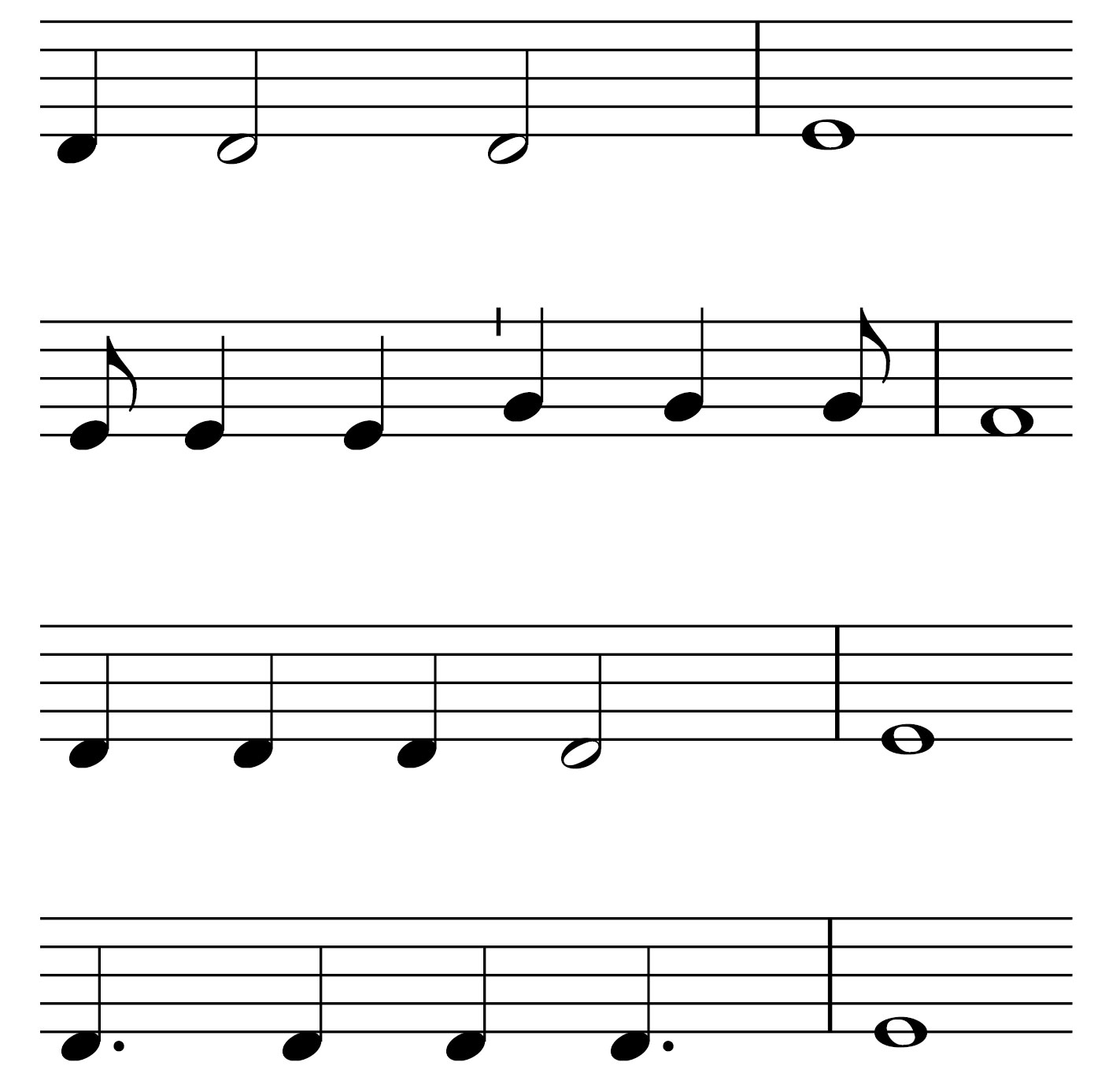
For modern performers, it is interesting to note that once the rhythmopoiia principles are used to decipher Ganassi’s diminutions, it actually becomes more accessible and easier to play. The example below shows two versions of a more flourished diminution of an ascending fifth in Regola Seconda. The first version, taken from a modern edition of Fontegara, presents the shorter notes beamed in a somewhat random manner. The second version presents the very same diminution but transcribed according to the principles of rhythmopoiia, giving due importance to the notes of the original interval (marked in red) and to inversion of rhythmic units. In fact, transcribed according to the principles of rhythmopoiia, this diminution is easily recognisable as a flourished version of a rhythmic pattern very typical to Ganassi, as seen in the purely rhythmic diminution below it.
RS-5ascM1A7 – two versions of the same diminution
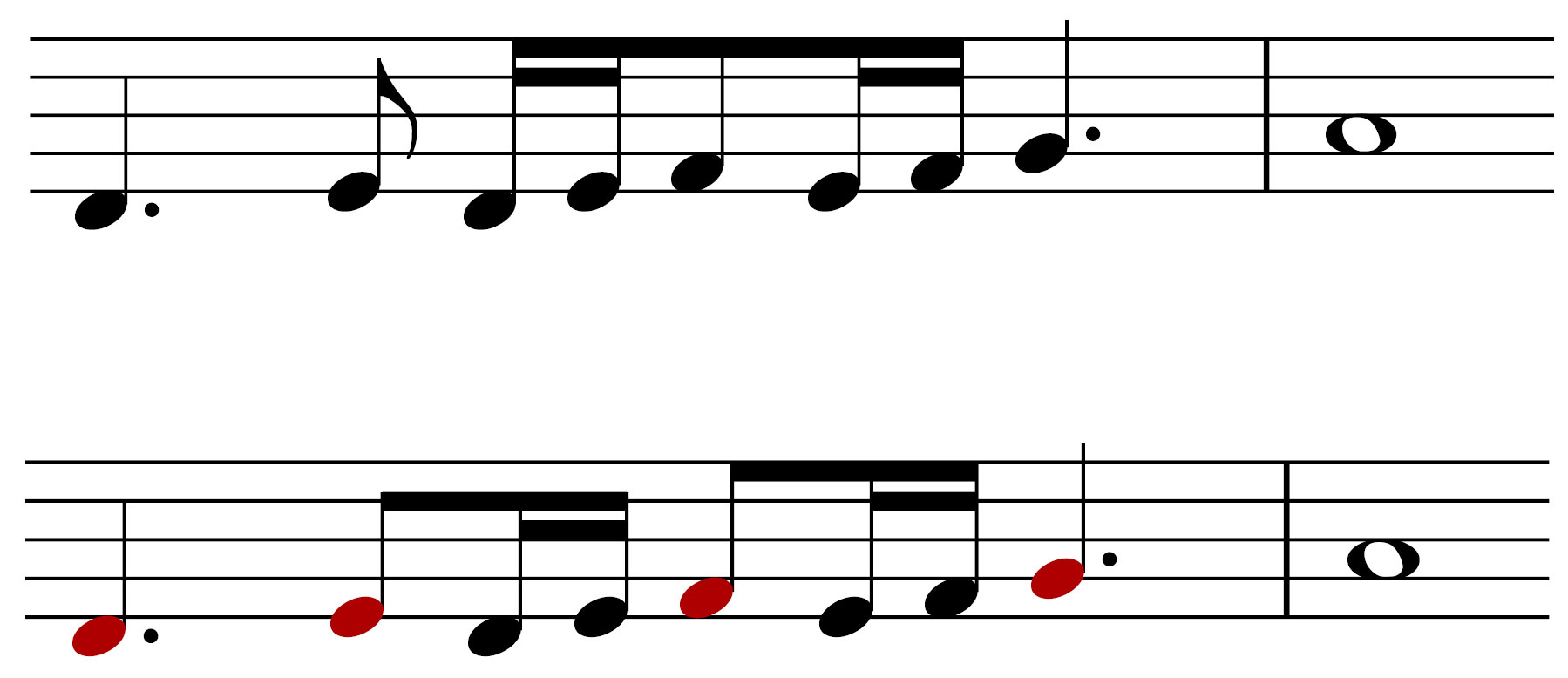
Purely rhythmic diminution as rhythmical matrix for RS-5ascM1A7

Finally, the presence of a pair of diminutions displaying such complex rhythmical figures, which are in full retrograde from each other, seems to discard the interpretation that Fontegara can be interpreted as a notated version of rhythmic freedom of improvisation or agogic of performance. Instead, Ganassi style emerges as a meticulously crafted invention in emulation of the Greek sources.
Diminutions displaying retrograde rhythms
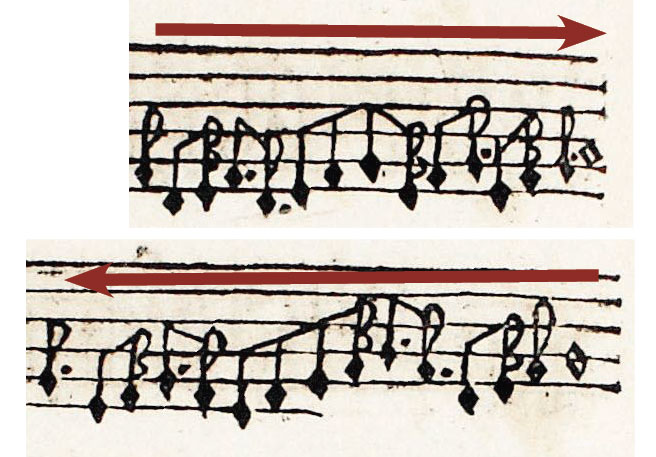
RT-3ascM3A4 and RT-3ascM4A4
Ganassi’s style suffices as intellectually crafted, serving one artistic goal: emulate the utterings of the human voice. Ganassi’s imitation of the human voice goes deeper than the admiration to the vocal flexibility: it is inherent of his diminution style constructed according to the principles rhythmopoiia and, by extension, a propeller of social valorisation of the instrumentalist. Bringing the antique poetic models to life, according to sources brought to Venice due to Bessarion’s Act of Donation, Ganassi’s Fontegara is best understood as a truly Renaissance cultural manifestation and an exponent of Andrea Gritti’s renovatio urbis, celebrating the antique cultural heritage and the city of Venice.
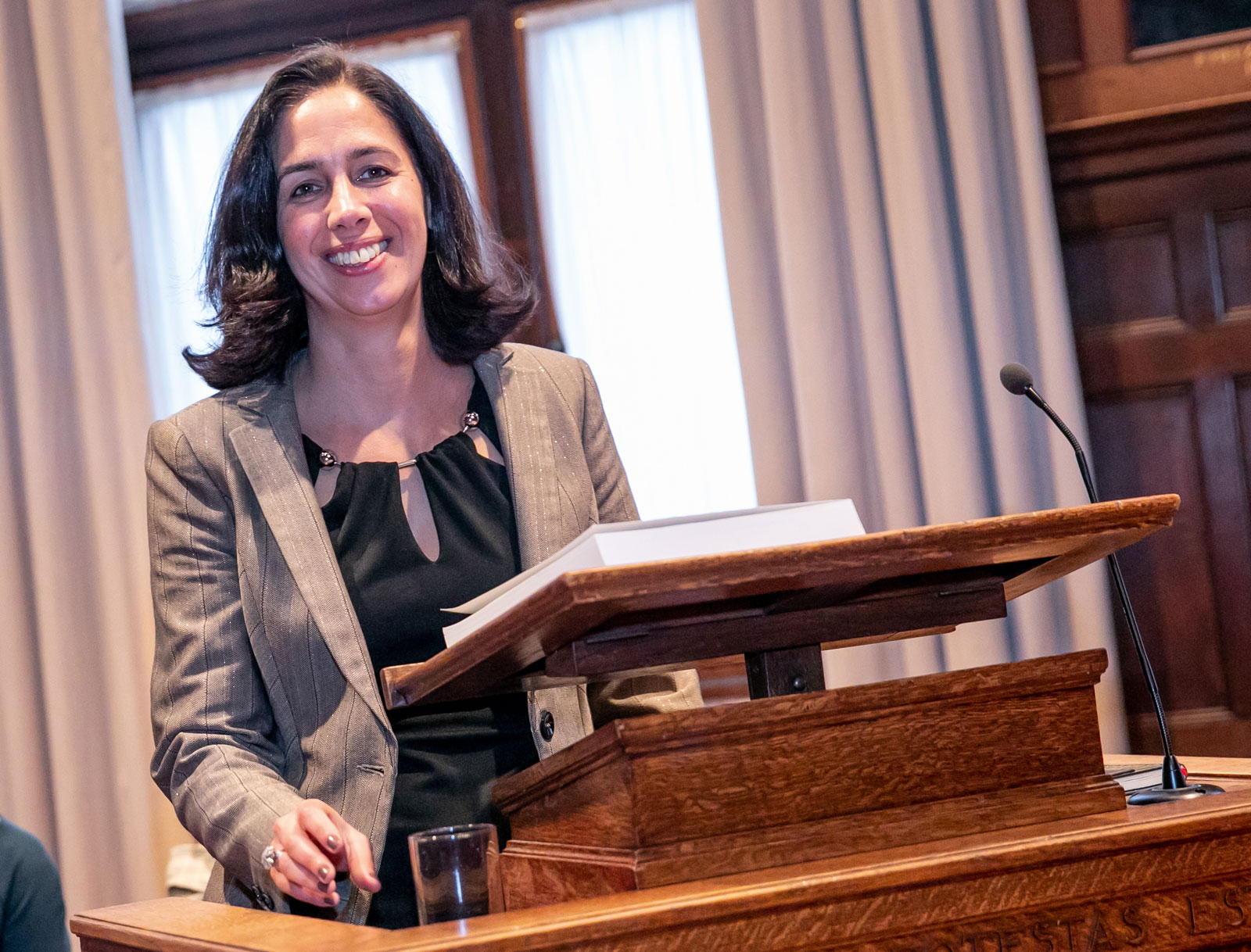
Dina Titan
Dina Titan’s musical education includes the Bachelor as recorder player at the Rotterdams Conservatorium, Bachelor and Master in Musicology at the University of Utrecht. She has a current position as Head of the Music Department at the International School of The Hague. She has received a 5 years grant from the NWO (Netherlands Organisation for Scientific Research) and recently has defended her dissertation concluding a doctorate diploma on the art of diminutions in Silvestro Ganassi’s treatise »Opera Intitulata Fontegara«.



 English
English







